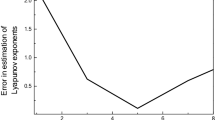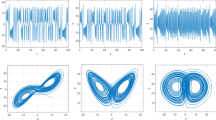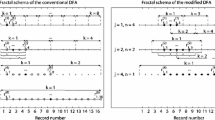Abstract
Stability analysis is a critical part of the study of a dynamical system that includes: finding the attractors of the system, determining their stability or instability, and identifying basins of attraction (BoAs) of the attractors. There are some classical methods for finding parts of BoAs, like Lyapunov-based and Non-Lyapunov-based methods; however, due to the limitations of the current methods, the identification of a complex boundary of a BoA is not feasible in addition to the high computational load of these methods. The concept of Lyapunov exponents is a powerful tool for performing stability analysis of highly nonlinear systems. In this paper, a new and intelligent approach for identifying the boundary of the entire BoA using Lyapunov exponents, Monte Carlo techniques, and support vector machine learning algorithm is developed. The proposed approach can identify the boundary of BoAs due to the intelligent sampling brought by Monte Carlo technique, which also dramatically reduces the computational load. Three illustrative examples are presented to demonstrate the effectiveness of the proposed approach.

















Similar content being viewed by others
References
Slotine, J.-J.E., Li, W., et al.: Applied nonlinear control, vol. 199. Prentice Hall, New Jersey (1991)
Śliwa, I., Grygiel, K.: Periodic orbits, basins of attraction and chaotic beats in two coupled kerr oscillators. Nonlinear Dyn. 67(1), 755–765 (2012)
de Freitas, M.S., Viana, R.L., Grebogi, C.: Basins of attraction of periodic oscillations in suspension bridges. Nonlinear Dyn. 37(3), 207–226 (2004)
Paradis, W., Perlmutter, D.: Tracking function approach to practical stability and ultimate boundedness. AIChE J. 12(1), 130–136 (1966)
Scofield, H.: An estimate of the stable initial condition region based on the describing function. IEEE Trans. Autom. Control 10(4), 484–485 (1965)
Luus, R., Lapidus, L.: An averaging technique for stability analysis. Chem. Eng. Sci. 21(2), 159–181 (1966)
Loparo, K., Blankenship, G.: Estimating the domain of attraction of nonlinear feedback systems. IEEE Trans. Autom. Control 23(4), 602–608 (1978)
Cruck, E., Moitie, R., Seube, N.: Estimation of basins of attraction for uncertain systems with affine and lipschitz dynamics. Dyn. Control 11(3), 211–227 (2001)
Wang, T.-C., Lall, S., West, M.: Polynomial level-set methods for nonlinear dynamical systems analysis. In: Proceedings of Allerton conference on communication, control, and computing, Allerton, IL, (2005)
Genesio, R., Tartaglia, M., Vicino, A.: On the estimation of asymptotic stability regions: state of the art and new proposals. IEEE Trans. Autom. Control 30(8), 747–755 (1985)
Cusumano, J., Kimble, B.: A stochastic interrogation method for experimental measurements of global dynamics and basin evolution: application to a two-well oscillator. Nonlinear Dyn. 8(2), 213–235 (1995)
Zakynthinaki, M.S., Stirling, J.R., Quintana, M.S., Romo, G.R., Molinuevo, J.S.: Modeling the basin of attraction as a two-dimensional manifold from experimental data: applications to balance in humans. Chaos Interdiscip. J. Nonlinear Sci. 20(1), 013119–013119 (2010)
Zakynthinaki, M.S., López, A., Cordente, C.A., Ospina Betancurt, J.A., Quintana, M.S., Sampedro, J.: Detecting changes in the basin of attraction of a dynamical system: application to the postural restoring system. Appl. Math. Comput. 219(17), 8910–8922 (2013)
Levin, A.: An analytical method of estimating the domain of attraction for polynomial differential equations. IEEE Trans. Autom. Control 39(12), 2471–2475 (1994)
Chiang, H.-D., Thorp, J.S.: Stability regions of nonlinear dynamical systems: a constructive methodology. IEEE Trans. Autom. Control 34(12), 1229–1241 (1989)
Tibken, B., Fan, Y.: Computing the domain of attraction for polynomial systems via bmi optimization method. In: American control conference, 2006, pp. 6. IEEE (2006)
Chesi, G., Garulli, A., Tesi, A., Vicino, A.: Lmi-based computation of optimal quadratic lyapunov functions for odd polynomial systems. Int. J. Robust Nonlinear Control 15(1), 35–49 (2005)
Balestrino, A., Caiti, A., Crisostomi, E., Grammatico, S.: R-composition of lyapunov functions. In: Control and automation, 2009. MED’09. 17th mediterranean conference, pp. 126–131. IEEE, (2009)
Ohta, Y.: Piecewise linear estimate of attractive regions for linear systems with saturating control. In: Proceedings of AMS (2002)
Milani, B.E.: Piecewise-affine lyapunov functions for discrete-time linear systems with saturating controls. Automatica 38(12), 2177–2184 (2002)
Hu, T., Lin, Z.: Properties of the composite quadratic lyapunov functions. IEEE Trans. Autom. Control 49(7), 1162–1167 (2004)
Chesi, G.: Rational lyapunov functions for estimating and controlling the robust domain of attraction. Automatica 49(4), 1051–1057 (2013)
Tibken, B.: Estimation of the domain of attraction for polynomial systems via lmis. In: Proceedings of the 39th IEEE conference on decision and control, 2000, vol. 4, pp. 3860–3864. IEEE (2000)
Hachicho, O., Tibken, B.: Estimating domains of attraction of a class of nonlinear dynamical systems with lmi methods based on the theory of moments. In: Proceedings of the 41st IEEE conference on decision and control, 2002, vol. 3, pp. 3150–3155. IEEE (2002)
Coutinho, D.F., de Souza, C.E., Trofino, A.: Stability analysis of implicit polynomial systems. IEEE Trans. Autom. Control 54(5), 1012–1018 (2009)
Jarvis-Wloszek, Z.W.: Lyapunov based analysis and controller synthesis for polynomial systems using sum-of-squares optimization. PhD thesis, University of California (2003)
Papachristodoulou, A.: Scalable analysis of nonlinear systems using convex optimization. PhD thesis, Citeseer (2005)
Chesi, G. Robust domain of attraction: computing and controlling estimates with non-polynomial lyapunov functions. In: 2012 IEEE International Conference on control applications (CCA), pp. 1086–1091. IEEE (2012.)
Tan, W., Packard, A.: Stability region analysis using polynomial and composite polynomial lyapunov functions and sum-of-squares programming. IEEE Trans. Autom. Control 53(2), 565–571 (2008)
Sun, Y., Wu, C.Q.: A radial-basis-function network-based method of estimating lyapunov exponents from a scalar time series for analyzing nonlinear systems stability. Nonlinear Dyn. 70(2), 1689–1708 (2012)
Nusse, H.E., Yorke, J.A., Hunt, B.R.: Dynamics: numerical explorations, vol. 101. Springer, Berlin (1998)
Sun, Y., Wu, C.Q.: Stability analysis via the concept of lyapunov exponents: a case study in optimal controlled biped standing. Int. J. Control 85(12), 1952–1966 (2012)
Koop, D., Wu, C.Q.: Passive dynamic biped walking part ii: stability analysis of the passive dynamic gait. ASME Comput. Nonlinear Dyn. 85(12), 1952–1966 (2012)
Wolf, A., Swift, J.B., Swinney, H.L., Vastano, J.A.: Determining lyapunov exponents from a time series. Phys D Nonlinear Phenom 16(3), 285–317 (1985)
Zeng, X., Eykholt, R., Pielke, R.: Estimating the lyapunov-exponent spectrum from short time series of low precision. Phys. Rev. Lett. 66(25), 3229 (1991)
Oseledec, V.I.: A multiplicative ergodic theorem. Lyapunov characteristic numbers for dynamical systems. Trans. Moscow Math. Soc. 19(2), 197–231 (1968)
Kroese, D.P., Chan, (eds): Common statistical models. In: Statistical Modeling and Computation, pp. 101–120, Springer, New York (2014)
MacKay, D.J.: Introduction to monte carlo methods. In : Jordan, M.I. (ed.) Learning in Graphical Models, pp. 175–204, Springer, The Netherlands (1998)
Bishop, C.M., Nasrabadi, N.M.: Pattern recognition and machine learning, vol. 1. Springer, New York (2006)
Carter, L.L., Cashwell, E.D.: Particle-transport simulation with the monte carlo method. Technical report, Los Alamos Scientific Lab, N. Mex. (USA) (1975)
Andrieu, C., De Freitas, N., Doucet, A., Jordan, M.I.: An introduction to mcmc for machine learning. Mach. Learn. 50(1–2), 5–43 (2003)
Lin, C.-F., Wang, S.-D.: Fuzzy support vector machines. IEEE Trans. Neural Netw. 13(2), 464–471 (2002)
Joachim, T.: Text categorization with support vector machines: Learning with many relevant features. Springer, Berlin (1998)
Suykens, J.A., Vandewalle, J.: Least squares support vector machine classifiers. Neural Process. Lett. 9(3), 293–300 (1999)
Campbell, W.M., Sturim, D.E., Reynolds, D.A.: Support vector machines using gmm supervectors for speaker verification. Signal Process. Lett. IEEE 13(5), 308–311 (2006)
Cristianini, N., Shawe-Taylor, J.: An introduction to support vector machines and other kernel-based learning methods. Cambridge University Press, UK (2000)
Platt, J., et al.: Sequential minimal optimization: a fast algorithm for training support vector machines. Technical report msr-tr-98-14, Microsoft Research (1998)
Fan, R.-E., Chen, P.-H., Lin, C.-J.: Working set selection using second order information for training support vector machines. J. Mach. Learn. Res. 6, 1889–1918 (2005)
Bottou, L., Lin, C.-J.: Support vector machine solvers. In: Large Scale Kernel Machines. MIT Press, Cambridge, MA (2007)
Perko, L.: Differential equations and dynamical systems. Texts in applied mathematics. Springer, Berlin (1991)
KuznetÍsov, I.: Elements of Applied Bifurcation Theory, Vol. 112. Springer, New York (1998)
Feng, Z.: Exact solutions to the liénard equation and its applications. Chaos, Solitons & Fractals 21(2), 343–348 (2004)
“Wikipedia”, August 2013
Pacejka, H.: Tyre and Vehicle Dynamics. Elsevier, Amsterdam (2005)
Gillespie, T.D.: Fundamentals of vehicle dynamics (r-114). SAE International (1992)
Goodarzi, A., Armion, A.: Integrated fuzzy-optimal motorcycle dynamic control. Veh. Syst. Dyn. 48(S1), 505–524 (2010)
Mashadi, B., Majidi, M., Dizaji, H.P.: Optimal vehicle dynamics controller design using a four-degrees-of-freedom model. Proc. Inst. Mech. Eng. D J. Autom. Eng. 224(5), 645–659 (2010)
Pham, D., Otri, S., Afify, A., Mahmuddin, M., Al-Jabbouli, H.: Data clustering using the bees algorithm . In: Proceedings of 40th CIRP International Manufacturing Systems Seminar (2007)
Dahlquist, G., Björck, Å.: Numerical methods in scientific computing, vol. i. SIAM, Philadelphia (2007)
Ko, Y.E., Lee, J.M.: Estimation of the stability region of a vehicle in plane motion using a topological approach. Int. J. Vehicle Des. 30(3), 181–192 (2002)
Ko, Y., Song, C.: Vehicle modeling with nonlinear tires for vehicle stability analysis. Int. J. Autom. Technol. 11(3), 339–344 (2010)
Jensen, J.S.: Non-linear dynamics of the follower-loaded double pendulum with added support-excitation. J. Sound Vib. 215(1), 125–142 (1998)
Thomson, J.: Chaotic dynamics of the partially follower-loaded elastic double pendulum. J. Sound Vib. 188(3), 385–405 (1995)
Author information
Authors and Affiliations
Corresponding author
Rights and permissions
About this article
Cite this article
Armiyoon, A.R., Wu, C.Q. A novel method to identify boundaries of basins of attraction in a dynamical system using Lyapunov exponents and Monte Carlo techniques. Nonlinear Dyn 79, 275–293 (2015). https://doi.org/10.1007/s11071-014-1663-z
Received:
Accepted:
Published:
Issue Date:
DOI: https://doi.org/10.1007/s11071-014-1663-z




